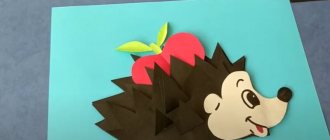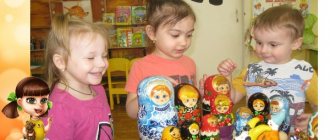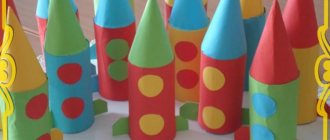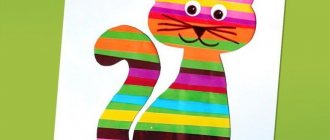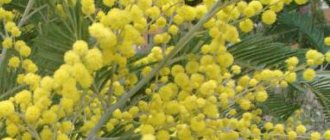Summary of a lesson on application in an early age group. Theme: Matryoshka
Summary of a lesson on artistic and aesthetic development (application) in an early age group on the topic: “Visiting the nesting doll”
Purpose: Acquaintance with the Russian folk toy - the nesting doll. Formation of independence in productive activities in children. Objectives: educational:
to create in children an interest in the folk toy, the desire to decorate the nesting doll sundress with a pattern using ready-made forms;
continue to teach children to work sequentially, to place finished parts in the center. developing:
to develop aesthetic perception, attention, memory, eye, perseverance, creative activity.
educational:
to cultivate independence, accuracy, self-confidence and the ability to complete the work started.
Progress OD
The bell rings, the children approach the teacher.
- Chok-chok-chok, close the tongue in the chest, lock the chest with a hook and silence. - Guys, today you and I will go on a visit and we will ride on a steam locomotive. Get up one after another, let's go. (song of the locomotive “Bukashka”). - Blow the pipes, beat the spoons! We came to visit ... (matryoshka). Right. To the nesting doll. Let's say hello to the nesting doll. - Matryoshka, matryoshka - Russian beauty, rosy cheeks, turquoise eyes, white shirt and Russian sundress. There is a scarf on your head, you won’t find a flaw! - How beautiful our nesting doll is! look how beautiful her outfit is. -What is she wearing on her head? (handkerchief) - What is the nesting doll wearing on its body? Children's answers (that's right, sundress) - Guys, what is painted on the sundress? Children's answers (flowers) - But our nesting doll does not live alone, she lives with her friends. Just look, these nesting dolls have lost the flowers from their sundresses. Let's make their sundresses beautiful again and stick flowers on them?
- I have prepared flowers, you can stick them on the sundresses of the nesting dolls.
But first, watch how I do it. — I put the colored side down, take a brush, put a little glue on it, spread it on the flower, then glue it to the sundress and press it with a cloth, then take the middle and do the same. — Before you start decorating sundresses, let’s stretch your fingers . We are beautiful matryoshka dolls, Multi-colored clothes. One is Matryona, Two is Malasha, Mila is three, Four is Masha, Margarita is five. It's not hard to count us! — Hold the nesting dolls and go to the table. Take flowers from the baskets, place them with the colored side down, take a brush, pick up glue, spread the flower, glue it to the sundress, press with a cloth. (the teacher controls and helps the children), then glue on the middle. Turn on Russian folk music.
The teacher reads
a poem : - All nesting dolls love colorful clothes.
Let's try a little, the nesting doll will be joyful. - Well done guys, you all did well. Let's bring the nesting dolls home. Now they are also beautiful, elegant and say thank you. - It’s time for us to return to the group. We say goodbye to the nesting dolls and go home on the steam locomotive. (we return to the music). - Where were we, guys, today? (visiting the nesting doll). — How did you decorate the sundresses with matryoshka dolls? (flowers). - Well done, you did very well. - Now let’s wash the glue from the handles. (go to wash hands). Practical part of the lesson
For children to work on the table: the basis for the applique is a matryoshka doll, flower details, glue, a brush, a rag.
Matryoshka template for cutting
Place the first part of the flower with the colored side down and spread with glue.
Stick it on a matryoshka sundress and press it with a cloth.
The next part is the middle of the flower, spread with glue, turning the colored side down.
Stick to the middle of the flower.
Final result.
We recommend watching:
Joint activities in an early age group. Synopsis of a lesson with children in the first year of life Synopsis of a joint educational activity for children of the 1st junior group “Winter-Winter” Complex thematic lesson in an early age group together with mothers
Similar articles:
Lesson summary for an early age group. Cockerel
Lesson summary for an early age group. Dandelion
Summary of a game developmental lesson in an early age group on the topic: Rays of the sun
Game development activity in kindergarten for children of the third year of life
Lesson summary for the first early age group on the topic: Toys
Summary of direct educational activities in the senior group “Matryoshka”
Lesson notes on the application “Matryoshka”
MBDOU No. 62 “Rodnichok”
Authors: Kazachkova Elizaveta Sergeevna - teacher,
Dvoretskaya Elena Arkadyevna - teacher
Age:
senior group
Subject:
"Matryoshka"
Purpose of the lesson:
To promote the ability to create an image of a folk toy (matryoshka) using the appliqué technique.
Tasks:
1. Teach children to analyze a sample to identify characteristic features
(Components: face, hands, sundress, scarf)
2. Teach children to consciously select matryoshka parts in the chosen color scheme.
3. Continue training in work planning.
4. Teach how to capture an idea in an original artistic image.
5. Continue teaching how to cut out an object using a stencil and carefully stick on the applique elements
Equipment:
paper, fabric, glitter, scissors, glue, brush, pencil.
Bibliography:
Arapova S.V. Fine arts training. Integration of artistic and logical. - St. Petersburg: KARO, 2004. - (Modernization of general education).
Gusakova M. A. Application. - M.: Education, 1982.
Dubrovskaya N.V. Invitation to creativity: teaching preschoolers the technique of appliqué and collage. - St. Petersburg: “CHILDHOOD-PRESS”, 2004. - 128 p.
Progress of the lesson:
Organizing time.
Hello guys.
What could such a box be filled with?
Of course, with old Russian things. I'll tell you a secret. The box is filled with toys.
So, let's open the box? I'm looking for a wonderful toy. Guess which one?
We're at the fair
They brought you a chest - a gilded barrel. That chest is not simple, and the goods in it are painted. We take it out for display - And we tell a story about it.
A scarlet silk scarf, a bright sundress in a flower, resting the hand on the wooden sides. And inside there are secrets: Maybe 3, or maybe 6. She didn’t blush a little (children’s answers...? Matryoshka)
Presentation and conversation.
Now I’ll tell you guys about this wonderful toy – a matryoshka. After all, you probably have such a house and a toy?
Who has?
The first Russian matryoshka was an eight-seater: a girl with a black rooster was followed by a boy, then a girl, and so on. All the figures were different from each other. The last one, the eighth, depicted a baby.
Initially, this doll didn’t even have a name. But when the turner made it out of wood, the artist painted it with bright colors, then the name appeared - M?atryona. Perhaps this is due to the fact that at various evenings tea was served by a servant with that name. Why was everyone’s favorite Russian doll-toy called “matryoshka”? Many believe that this name comes from the female name Matryona, very popular at that time in Russia. The name Matryona, translated from Latin, means “noble woman.” Looking at the matting doll, the image of a portly, noble and toy really appears.
Maneki-neko in paper version
Usually matryoshka cats are made of wood. But even if they are made of paper using the origami technique, they are unlikely to lose their “magic” functions. For the Japanese talisman “for good luck” you will need 4 square sheets of different colors, sizes 15x15, 13x13, 11x11 and 9x9 cm.
Step-by-step instruction:
- We take the largest square blank.
- We place it with the top forward, fold it in half from bottom to top.
- We bend the left corner obliquely so that its top “rests” against the opposite edge.
- We do the same with the right one.
- Fold the top layer of the triangular flap forward.
- We tuck it into the lower trapezoidal “pocket”.
- We bend the second layer of the valve. We put it inside the resulting “glass”.
- Turn the workpiece 180°. We press our finger on the upper part of it to mark the ears. We draw the cat's face, as well as a tail and paws. According to Japanese tradition, one of them can be raised to attract good luck.
With a paper maneki-neko, young children will be able to act out theatrical scenes, inventing their own character for each member of the cat family. So, along with logic, an unusual nesting doll will allow you to develop your imagination.
If maneki-neko seems too exotic, the same scheme is suitable for making a classic Russian origami matryoshka doll. There is no need to press the figure with your finger at the top. The rest of the assembly algorithm is absolutely identical.
Goals:
introduce the history of the Russian nesting doll;
consolidate children's knowledge of techniques for working with various materials using the collage technique;
develop horizons, fine motor skills, aesthetic taste and imagination;
cultivate perseverance and accuracy;
realize the connection between the labor training lesson and the decorative work lesson: painting the “matryoshka doll” pattern.
Equipment: a set of nesting dolls, pictures with Russian toys, cardboard, colored paper, scraps of fabric, scissors, braid, glue, buttons, pencils, felt-tip pens, oilcloth.
DURING THE CLASSES
I. Introductory part
1. Greeting, organizational moment.
2. Repetition of safety rules.
– When a person works, he often uses various tools and assistants in his work. Let's remember them and check if everything is ready to go. I’ll tell you one poem, and you check your workplace:
To get started we'll put everything in its place. Scissors, paper, glue Be careful, don't spill! Markers and pencils, put them aside for now! Cardboard, templates, scraps Bows, laces and curls Place everything on oilcloth! Tell me what I forgot!
– Do you have dangerous objects on your table?
– How should we treat them?
II. Work on the topic
1. Teacher's message
– The world of toys is surprisingly diverse. Fairy tales and reality live side by side here. The toys reflected people's life, habits, and mood in their own way. Each nation created its own toys, conveying its life into them. We won’t talk about all the toys today. Our conversation will focus on folk toys. Look at them, here they are (exhibition on the board). What are these toys? Can someone help me and name them? Different toys are made from different materials: clay, wood. They are in great demand and serve to decorate people's lives. Try to guess the riddle about one such toy:
“The girlfriends are different in height. And they look alike. They all sit next to each other, And there’s only one toy.” (Matryoshka)
– That’s right, our lesson today will be dedicated to the Matryoshka – a symbol of friendship and love, wishes for happiness and prosperity. Do you want to know how the nesting doll was born? One day, a Japanese wooden toy fell into the hands of Moscow region artists - a Japanese man, and in it, little by little, his whole family. That’s when they decided to ask the famous craftsman from Zagorsk, Vasily Zvezdochkin, to carve (carve) his own national toy – the Russian nesting doll – from wood. The wooden nesting doll was painted by artists. They dressed her in a beautiful sundress with an apron (textured), an embroidered blouse and tied a scarf on her head. That’s how the matryoshka was born - a Russian one, and (show) there were small, small, smaller girls and boys in it, and the last one was a swaddled baby. The first matryoshka was held in the hands of a cockerel (show). Both adults and children immediately liked the matryoshka doll. She became a welcome guest in every home and Russian souvenirs abroad. Many poems and songs have been dedicated to this toy, let's listen to one of them. If you want to learn more, you can ask the library for help and borrow additional material.
2. Reading poems (children)
I don’t know who created the nesting doll. But I know that for hundreds of years, together with Vanka-Vstanka, as if alive, the doll has been conquering the white light.
Where did he get the paints, a skilled craftsman, in the noisy fields, in the fairytale forest? Created an image of unearthly passion. True Russian beauty.
3. Working with the product.
– Today in class we will try to make a flat matryoshka doll. For this we will need various materials: fabric, buttons, lace. Often in the house you can find many such unnecessary small things, don’t think about throwing them away - with their help you can create amazing works called “collage” (French word) (on a board). Collage (applique) - this means gluing various materials onto a base at the same time: pieces of fabric and photographs, biscuits and lace, beads and old letters. To make it more clear to you, we will conduct a collage warm-up. Before starting serious work, let's try to use this technique in a simple way.
(1. A drawn shoe, but without laces: “What are your impressions?” 2. “We make a hole with an awl and insert a lace”) 3. Collage: “What are your impressions?”).
– Today you will be authors-artists. Your work is “Matryoshka”. Let's make a work plan:
1. Cut out all the parts from thin paper (symbol on the board)
2. Cut out the details of the sundress from the template and fabric.
3. Glue the fabric parts onto the base – matryoshka doll
4. Decorate (decorate) the nesting doll with braid, ribbons, buttons, etc.
5 . Color the face and remaining parts with markers and pencils.
III. Practical work
IV. Lesson summary
Analysis of finished works. Finished works are displayed on the board. Express exhibition “Round dance” in a circle.
– What new did you learn in class today? – What French word did you become familiar with? – What does it mean translated into Russian? – Look at the Round Dance of nesting dolls, which ones do you think are the most successful? – What mood do they evoke in you? – Let's applaud all of us for our creative work in today's lesson. Thank you for the lesson.

